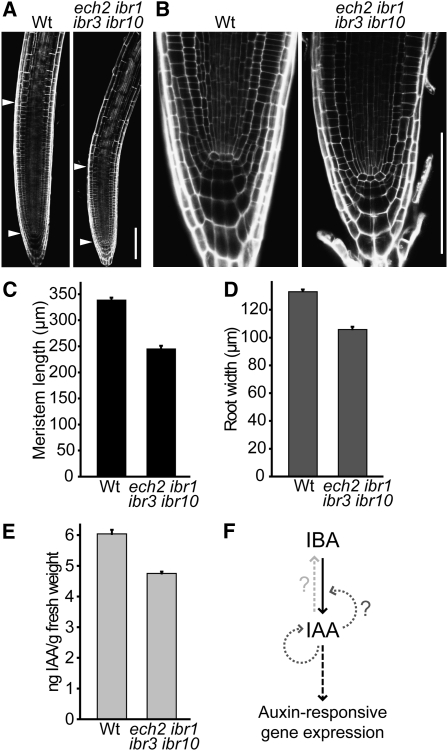Figure 8.
ech2 ibr1 ibr3 ibr10 Displays Meristem Defects and Decreased Auxin Levels.
(A) Confocal images of propidium iodide–stained root tips from 7-d-old light-grown wild-type (Wt) and ech2-1 ibr1-2 ibr3-1 ibr10-1 seedlings. Arrowheads delineate the top and bottom of the root meristem. Bar = 100 μm.
(B) Confocal images of propidium iodide–stained root tips from 7-d-old light-grown wild-type and ech2-1 ibr1-2 ibr3-1 ibr10-1 seedlings. Bar = 100 μm.
(C) Mean meristem lengths (+se; n ≥ 47) of 8-d-old light-grown wild-type and ech2-1 ibr1-2 ibr3-1 ibr10-1 seedlings.
(D) Mean root widths (+se; n ≥ 47) in the elongation zone of 8-d-old light-grown wild-type and ech2-1 ibr1-2 ibr3-1 ibr10-1 seedlings.
(E) Mean IAA levels (+se; n ≥ 3) in 5-mm root tips from light-grown wild-type and ech2-1 ibr1-2 ibr3-1 ibr10-1 seedlings.
(F) A model for the effects of IBA-to-IAA conversion on the auxin pool. IBA is converted to IAA in a process similar to peroxisomal fatty acid β-oxidation (solid black arrow). IAA also can be converted to IBA (dashed gray arrow; reviewed in Ludwig-Müller, 2000). Reduced DR5-GUS activity and decreased lateral root formation in ech2 ibr10 mutants treated with active auxins suggests that IBA-to-IAA conversion is necessary for full response to active auxins, either because auxin stimulates IBA-to-IAA conversion (positive feedback loops; dotted gray arrows) or because additional auxin is required to overcome the auxin deficit that results from blocking IBA-to-IAA conversion. Ultimately, increased auxin levels promote auxin signaling (dashed black arrow).

